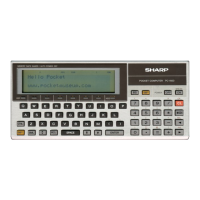-
PC-1600
6. Power supply
6-1. Kinds of power supplies
Power Voltage
Oescription
~
supply
range
!
VGG
4.0 ~ 4.7V
• Logic driving power which is on while
I
the system is not operating. Power is
i
supplied to the chips that need protec-
tion.
(1) RAM16KB
Memory protectlon
(2) LU57813P
Real-time timer and wake-up timer
protection
(3) H061102
Display data protection which is
required to activate the display at
power-on after auto power-off.
(4) LR38041
To maintain the signal level of such as
the memory select signal at a non-
active level.
VCC 4.0 - 4.7V
• Logic driving power which is shut off
when the system is turned off. Power is
supplied to the chips that do not need
protection when the system is off.
(1)ROM
256Kbit
(2)CPU
SC7852, LH5803
(3) H061203(S)
LCD common driver chip
(4) TC8576F
UART LSI
VEE
Approx.
• For creation of a low voltage to the
-8.5V
LCO drive voltage and the RS·232C
interface signals.
VOD
Approx
• For creation of a high voltage to the
6.0V
RS-232C interface signals. This voltage,
however, is supplied when PRIME is at
a high level (RS·232C is chosen) and
shut off when PRIME is a low level.
6-2. Power generation method
The following power supply sources are used to generate
the above power requirements.
(1) Internal dry battery cells (x
4)
(2) Through the AC adaptor
(3) Supplied through the VBAT of the system bus
A high voltage supply level is used by the PC-1600.
(i) VGG
A
voltage of
about 4.7V
is normally supplied
from the above source. The voltage drops when
the level of power supply decreases.
(iil VCC
VGG is supplied through this line, when BFO is at
a low level or ACL is at a high level.
VCC is not supplied when the system is off.
(iii) VEE
VEE is supplied when the system is turned on.
(iv) VDD
VDD is supplied when the PRIME output is at a
high level with the system on.
6-3. System-on/system-off
The on/off state of the system is controlled by the LU
57813P. The on/off state of the system is seen on the
BFO output. When BFO is low, the system is on and
VCC and VEE are available. When the system is off, no
power is supplied except VGG.
(1) System-off to system-on
There are five ways.
(i) Use of the BREAK/ON key
(ii) By means of the wake-up function
Possible to disable with mask
(iii) By means of the RS·232C interfacing CI signal
(iv) Use of the ALL RESET switch (ACL signal)
located on the back of the PC-1600
(v) By means of the reset input from the CE-1600P
Normally, the svstern is turned off with (i).
(21 System-on to system-off
There are two ways.
(i) By means of the Z-80 command
(ii) By means of the weak battery detect signal (03)
7. System operation
7-1. System-off operation
LSls operated by VGG, except for the LU57813P, are
assigned to protect their contents.
For the LU57813P, the real timer needs to be revised when
the system is off. So, an interrupt is sent to the LU57813P
by the internal timer every 0.5 second
to
revise the real
timer. When seconds are carried to aminute, the time is
verified with the wake-up timer and the alarm time. There-
fore, a system
clock
(153.6KHz or 307.2 KHz) is issued on
FOUT of the LU57813P every 0.5 second,
The system starts to rise when 01 of the CI connected
subcontroller remains high for more than the predeter-
mined time; the system wake-up is also possible by the CI
input
of
the RS-232C interface which is input at 0.5
second intervals.
But, if the system is forced off because of a weak battery
condition (03 input at high), the 0.5 second interval timer
interrupt is not activated even if the weak battery
con-
dition is cleared.
11\

